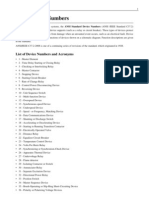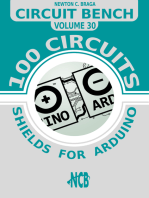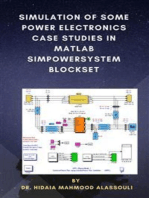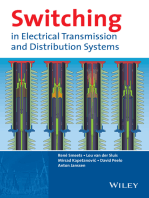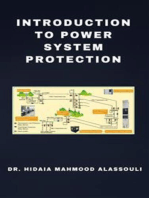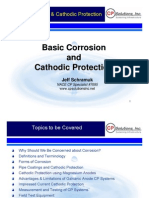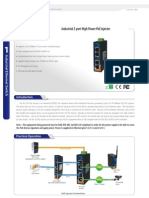0 ratings0% found this document useful (0 votes)
343 viewsANSI Device Numbers
ANSI Device Numbers
Uploaded by
Bharath SaiThe ANSI standard device numbers identify the functions of protective devices like relays and circuit breakers used in electrical power systems. Device numbers are shown on schematics and describe features such as overcurrent protection, synchronization, voltage regulation, and more. The standard is revised periodically to account for new technologies. Suffix letters further specify the purpose and function of different devices.
Copyright:
© All Rights Reserved
Available Formats
Download as DOCX, PDF, TXT or read online from Scribd
ANSI Device Numbers
ANSI Device Numbers
Uploaded by
Bharath Sai0 ratings0% found this document useful (0 votes)
343 views4 pagesThe ANSI standard device numbers identify the functions of protective devices like relays and circuit breakers used in electrical power systems. Device numbers are shown on schematics and describe features such as overcurrent protection, synchronization, voltage regulation, and more. The standard is revised periodically to account for new technologies. Suffix letters further specify the purpose and function of different devices.
Original Description:
av
Copyright
© © All Rights Reserved
Available Formats
DOCX, PDF, TXT or read online from Scribd
Share this document
Did you find this document useful?
Is this content inappropriate?
The ANSI standard device numbers identify the functions of protective devices like relays and circuit breakers used in electrical power systems. Device numbers are shown on schematics and describe features such as overcurrent protection, synchronization, voltage regulation, and more. The standard is revised periodically to account for new technologies. Suffix letters further specify the purpose and function of different devices.
Copyright:
© All Rights Reserved
Available Formats
Download as DOCX, PDF, TXT or read online from Scribd
Download as docx, pdf, or txt
0 ratings0% found this document useful (0 votes)
343 views4 pagesANSI Device Numbers
ANSI Device Numbers
Uploaded by
Bharath SaiThe ANSI standard device numbers identify the functions of protective devices like relays and circuit breakers used in electrical power systems. Device numbers are shown on schematics and describe features such as overcurrent protection, synchronization, voltage regulation, and more. The standard is revised periodically to account for new technologies. Suffix letters further specify the purpose and function of different devices.
Copyright:
© All Rights Reserved
Available Formats
Download as DOCX, PDF, TXT or read online from Scribd
Download as docx, pdf, or txt
You are on page 1of 4
ANSI device numbers
From Wikipedia, the free encyclopedia
In the design of electrical power systems, the ANSI standard device numbers (ANSI
/IEEE Standard C37.2 Standard for Electrical Power System Device Function Numbers, Acronyms,
and Contact Designations ) identifies the features of a protective device such as a relay or circuit
breaker. These types of devices protect electrical systems and components from damage when an
unwanted event occurs, such as an electrical fault. Device numbers are used to identify the functions
of devices shown on a schematic diagram. Function descriptions are given in the standard.
One physical device may correspond to one function number, for example "29 Isolating Switch", or a
single physical device may have many function numbers associated with it, such as a
numerical protective relay. Suffix and prefix letters may be added to further specify the purpose and
function of a device.
ANSI/IEEE C37.2-2008 is one of a continuing series of revisions of the standard, which originated in
1928.
List of device numbers and acronyms[edit]
2 – Time delay Starting or Closing Relay
3 – Checking or Interlocking Relay
4 – Master Contactor
5 – Stopping
6 – Starting Circuit Breaker
7 – Rate of Change Relay
8 – Control Power Disconnecting Device
9 – Reversing Device
10 – Unit Sequence Switch
11 – Multi-function Device
12 – Overspeed Device
13 – Synchronous-speed Device
14 – Underspeed Device
15 – Speed – or Frequency, Matching Device
16 – Data Communications Device
17 – Shunting or Discharge Switch
18 – Accelerating or Decelerating Device
19 – Starting to Running Transition Contractor
20 – Electrically Operated Valve
21 – Distance Relay
22 – Equalizer Circuit Breaker
23 – Temperature Control Device
24 – Volts Per Hertz Relay
25 – Synchronizing or Synchronize-Check Device
26 – Apparatus Thermal Device
27 – Undervoltage Relay
27s - DC under voltage Relay
28 – Flame detector
29 – Isolating Contactor or Switch
30 – Annunciator Relay
31 – Separate Excitation
32 – Directional Power Relay or Reverse Power Relay
33 – Position Switch
34 – Master Sequence Device
35 – Brush-Operating or Slip-Ring Short-Circuiting Device
36 – Polarity or Polarizing Voltage Devices
37 – Undercurrent or Underpower Relay
38 – Bearing Protective Device
39 – Mechanical Condition Monitor
40 – Field (over/under excitation) Relay
41 – Field Circuit Breaker
42 – Running Circuit Breaker
43 – Manual Transfer or Selector Device
44 – Unit Sequence Starting Relay
45 – DC over voltage Relay
46 – Reverse-phase or Phase-Balance Current Relay
47 – Phase-Sequence or Phase-Balance Voltage Relay
48 – Incomplete Sequence Relay
49 – Machine or Transformer, Thermal Relay-OLR
50 – Instantaneous Overcurrent Relay
50G - Instantaneous Earth Over Current Relay (Neutral CT Method)
50N - Instantaneous Earth Over Current Relay (Residual Method)
50BF - Breaker failure
51 – AC Inverse Time Overcurrent Relay
51LR - AC Invers Time overcurrent (locked Roter) protection Relay
51G - AC Inverse Time Earth Overcurrent Relay (Neutral CT Method)
51N - AC Inverse Time Earth Overcurrent Relay (Residual Method)
52 – AC Circuit Breaker
52a - AC Circuit Breaker Position (Contact Open when Breaker Open)
52b - AC Circuit Breaker Position (Contact Closed when Breaker Open)
53 – Exciter or DC Generator Relay
54 – Turning Gear Engaging Device
55 – Power Factor Relay
56 – Field Application Relay
57 – Short-Circuiting or Grounding Device
58 – Rectification Failure Relay
59 – Overvoltage Relay
60 – Voltage or Current Balance Relay.
61 – Density Switch or Sensor
62 – Time-Delay Stopping or Opening Relay
63 – Pressure Switch
64 – Ground Detector Relay
64R - Restricted earth fault
64S - Stator earth fault
65 – Governor
66 – Notching or Jogging Device
67 – AC Directional Overcurrent Relay
67N- Directional Earth Fault relay
68 – Blocking Relay
69 – Permissive Control Device
70 – Rheostat
71 – Liquid Level Switch
72 – DC Circuit Breaker
73 – Load-Resistor Contactor
74 – Alarm Relay
75 – Position Changing Mechanism
76 – DC Overcurrent Relay
77 – Telemetering Device
78 – Phase-Angle Measuring Relay or "Out-of-Step" Relay
79 – AC Reclosing Relay (Auto Reclosing)
80 – Flow Switch
81 – Frequency Relay
82 – DC Reclosing Relay
83 – Automatic Selective Control or Transfer Relay
84 – Operating Mechanism
85 – Communications,Carrier or Pilot-Wire Relay
86 – Lockout Relay/Master Trip
87 – Differential Protective Relay
88 – Auxiliary Motor or Motor Generator
89 – Line Switch
90 – Regulating Device
91 – Voltage Directional Relay
92 – Voltage and Power Directional Relay
93 – Field Changing Contactor
94 – Tripping or Trip-Free Relay( trip circuit supervision Relay)
95 – For specific applications where other numbers are not suitable
96 – Busbar Trip Lockout relay
97 – For specific applications where other numbers are not suitable
98 – For specific applications where other numbers are not suitable
99 – For specific applications where other numbers are not suitable
150 – Earth Fault Indicator
AFD – Arc Flash Detector
CLK – Clock or Timing Source
DDR – Dynamic Disturbance Recorder
DFR – Digital Fault Recorder
DME – Disturbance Monitor Equipment
HIZ – High Impedance Fault Detector
HMI – Human Machine Interface
HST – Historian
LGC – Scheme Logic
MET – Substation Metering
PDC – Phasor Data Concentrator
PMU – Phasor Measurement Unit
PQM – Power Quality Monitor
RIO – Remote Input/Output Device
RTU – Remote Terminal Unit/Data Concentrator
SER – Sequence of Events Recorder
TCM – Trip Circuit Monitor
LRSS - LOCAL/REMOTE SELECTOR SWITCH
SOTF - Switch On To Fault
Suffixes and prefixes[edit]
A suffix letter or number may be used with the device number; for example, suffix N is used if the
device is connected to a Neutral wire (example: 59N in a relay is used for protection against Neutral
Displacement); and suffixes X,Y,Z are used for auxiliary devices. Similarly, the "G" suffix can denote
a "ground", hence a "51G" is a time overcurrent ground relay. The "G" suffix can also mean
"generator", hence an "87G" is a Generator Differential Protective Relay while an "87T" is a
Transformer Differential Protective Relay. "F" can denote "field" on a generator or "fuse", as in the
protective fuse for a pickup transformer. Suffix numbers are used to distinguish multiple "same"
devices in the same equipment such as 51-1, 51–2.[1]
Device numbers may be combined if the device provides multiple functions, such as the
instantaneous/time-delay AC over current relay denoted as 50/51.[1]
For device 16, the suffix letters further define the device: the first suffix letter is 'S' for serial or 'E' for
Ethernet. The subsequent letters are: 'C' security processing function (e.g. VPN, encryption), 'F'
firewall or message filter, 'M' network managed function, 'R' rotor, 'S' switch and 'T' telephone
component. Thus a managed Ethernet switch would be 16ESM.
You might also like
- IEC101 104 Balanced Unbalanced PDFDocument3 pagesIEC101 104 Balanced Unbalanced PDFBharath SaiNo ratings yet
- ANSI Device NumbersDocument4 pagesANSI Device NumbersAlexandru IoanNo ratings yet
- Codigo Ansi de Funciones de ProteccionesDocument5 pagesCodigo Ansi de Funciones de ProteccionesGerman SchwabNo ratings yet
- List of Device Numbers and AcronymsDocument7 pagesList of Device Numbers and AcronymsSharath Teja ReddyNo ratings yet
- List of Device Numbers and AcronymsDocument22 pagesList of Device Numbers and AcronymsewbedonNo ratings yet
- A Listing of ANSI Device NumbersDocument7 pagesA Listing of ANSI Device NumbersOhaneje UzomaNo ratings yet
- Ansi 37.2Document4 pagesAnsi 37.2octofantemNo ratings yet
- Ansi Code For Protective RelayDocument3 pagesAnsi Code For Protective RelayUNNI VENUGOPALNo ratings yet
- ANSI Device Numbers PDFDocument1 pageANSI Device Numbers PDFPutra Kusuma HarditoNo ratings yet
- ANSI Device NumbersDocument6 pagesANSI Device Numbersashish sahaNo ratings yet
- ANSI Device Numbers PDFDocument6 pagesANSI Device Numbers PDFS.M.Touhidur RahmanNo ratings yet
- ANSI Device NumbersDocument6 pagesANSI Device Numbersicoviny0% (1)
- ANSI Numbers For Protection DevicesDocument5 pagesANSI Numbers For Protection DevicesPrrashNo ratings yet
- Ansi Code For Protective RelayDocument3 pagesAnsi Code For Protective RelayBayu Jatmiko Utomo100% (1)
- List of Ansi Code For RelaysDocument3 pagesList of Ansi Code For RelaysFarahdinahNo ratings yet
- List of Device Numbers and AcronymsDocument7 pagesList of Device Numbers and AcronymsAnonymous IAKrngDaNo ratings yet
- Ansi CodesDocument3 pagesAnsi CodesMunavwar ProfessNo ratings yet
- ANSI Device NumbersDocument3 pagesANSI Device NumbersMasrurul Azni Abdul AzizNo ratings yet
- ANSI Device Numbers - WikipDocument3 pagesANSI Device Numbers - WikipSandeep SaikiaNo ratings yet
- ANSI Device NumbersDocument11 pagesANSI Device NumbersMilad Gholami fardNo ratings yet
- ANSI Device NumbersDocument4 pagesANSI Device Numbersvraja76No ratings yet
- Device Numbers and Acronyms As Per IEEE or ANSIDocument6 pagesDevice Numbers and Acronyms As Per IEEE or ANSIurkirannandaNo ratings yet
- ANSI Device Numbers - WikipediaDocument8 pagesANSI Device Numbers - WikipediaHenry UrdanetaNo ratings yet
- ANSI CODES For Protection DevicesDocument2 pagesANSI CODES For Protection DevicesHarpreet Singh BathNo ratings yet
- ANSI Codes For Protection FunctionsDocument3 pagesANSI Codes For Protection FunctionsAmir Mahdavian100% (1)
- ANSI Protection Codes - WikiDocument3 pagesANSI Protection Codes - WikiSatinderpal SinghNo ratings yet
- ANSI Device NumbersDocument6 pagesANSI Device Numbersfake fNo ratings yet
- ANSI Device Numbers - WikipediaDocument8 pagesANSI Device Numbers - Wikipediahemant kumarNo ratings yet
- Coduri ANSIDocument2 pagesCoduri ANSIAnonymous 9rdcwejNo ratings yet
- Simbol Legend Manual Proteksi TransformerDocument9 pagesSimbol Legend Manual Proteksi Transformerrizqan acilNo ratings yet
- ANSI Device Numbers - WikipediaDocument8 pagesANSI Device Numbers - WikipediaAli MohsinNo ratings yet
- List of Device Numbers and Acronyms: Distance RelayDocument4 pagesList of Device Numbers and Acronyms: Distance Relayaloknayak1984No ratings yet
- ANSI Device Numbers - Wikipedia, The Free EncyclopediaDocument4 pagesANSI Device Numbers - Wikipedia, The Free EncyclopediaShadab WaseemNo ratings yet
- AC Apparatus & DevicesDocument4 pagesAC Apparatus & DevicesBrian Kim Benoza100% (1)
- Flame Detector: Ansi Device NumberDocument4 pagesFlame Detector: Ansi Device NumberIlham HendratamaNo ratings yet
- Ansi Device NumbersDocument3 pagesAnsi Device NumbersAshley RequenezNo ratings yet
- Codes For Switchgear ProtectionDocument6 pagesCodes For Switchgear Protectionfake idNo ratings yet
- ANSI Device Numbers 2022Document7 pagesANSI Device Numbers 2022ajitkalel1986No ratings yet
- CodesDocument3 pagesCodesVishnu Vardhan Reddy BaitintiNo ratings yet
- ANSI Device NumberDocument5 pagesANSI Device NumberMarcos Andres Caceres AlmeidaNo ratings yet
- ANSI Device NumbersDocument4 pagesANSI Device Numberssajjad200537No ratings yet
- List of AnsiDocument6 pagesList of AnsiNikhil BindalNo ratings yet
- List of Device Numbers and AcronymsDocument10 pagesList of Device Numbers and AcronymsjadeericabarquezNo ratings yet
- ANSI Numbers Protection and ControlDocument2 pagesANSI Numbers Protection and ControlEshwar MadiwalNo ratings yet
- Protection Relay CodeDocument1 pageProtection Relay CodebenNo ratings yet
- Ieee - C37.2-2008Document1 pageIeee - C37.2-2008DANIEL3991No ratings yet
- Reference Guide To Useful Electronic Circuits And Circuit Design Techniques - Part 2From EverandReference Guide To Useful Electronic Circuits And Circuit Design Techniques - Part 2No ratings yet
- Reference Guide To Useful Electronic Circuits And Circuit Design Techniques - Part 1From EverandReference Guide To Useful Electronic Circuits And Circuit Design Techniques - Part 1Rating: 2.5 out of 5 stars2.5/5 (3)
- Simulation of Some Power Electronics Case Studies in Matlab Simpowersystem BlocksetFrom EverandSimulation of Some Power Electronics Case Studies in Matlab Simpowersystem BlocksetNo ratings yet
- Simulation of Some Power Electronics Case Studies in Matlab Simpowersystem BlocksetFrom EverandSimulation of Some Power Electronics Case Studies in Matlab Simpowersystem BlocksetRating: 2 out of 5 stars2/5 (1)
- Some Power Electronics Case Studies Using Matlab Simpowersystem BlocksetFrom EverandSome Power Electronics Case Studies Using Matlab Simpowersystem BlocksetNo ratings yet
- Analog Dialogue Volume 46, Number 1: Analog Dialogue, #5From EverandAnalog Dialogue Volume 46, Number 1: Analog Dialogue, #5Rating: 5 out of 5 stars5/5 (1)
- Introduction to Power System ProtectionFrom EverandIntroduction to Power System ProtectionRating: 5 out of 5 stars5/5 (1)
- Simulation of Some Power System, Control System and Power Electronics Case Studies Using Matlab and PowerWorld SimulatorFrom EverandSimulation of Some Power System, Control System and Power Electronics Case Studies Using Matlab and PowerWorld SimulatorNo ratings yet
- Analog Dialogue, Volume 48, Number 1: Analog Dialogue, #13From EverandAnalog Dialogue, Volume 48, Number 1: Analog Dialogue, #13Rating: 4 out of 5 stars4/5 (1)
- 2r3 BC Bay ReportDocument2 pages2r3 BC Bay ReportBharath SaiNo ratings yet
- For Successful Completion of The Alstom E Learning Workplace Electrical Safety Awareness (WESA) ModuleDocument2 pagesFor Successful Completion of The Alstom E Learning Workplace Electrical Safety Awareness (WESA) ModuleBharath SaiNo ratings yet
- 8x8 Led Matrix With AlphabetDocument9 pages8x8 Led Matrix With AlphabetBharath SaiNo ratings yet
- 9th-Implementing Lockout Function With IEC61850 PDFDocument11 pages9th-Implementing Lockout Function With IEC61850 PDFBharath SaiNo ratings yet
- IEC 60870-5-104 Ethernet Interface AL-3415: Product DescriptionDocument9 pagesIEC 60870-5-104 Ethernet Interface AL-3415: Product DescriptionBharath SaiNo ratings yet
- Flexus Surr 100 Spec Sheet v06Document1 pageFlexus Surr 100 Spec Sheet v06navaho2005No ratings yet
- MP204 For SP FinishDocument2 pagesMP204 For SP FinishRafita RamlandNo ratings yet
- Durabrand DBTV1901 Orion TV-1934ADocument63 pagesDurabrand DBTV1901 Orion TV-1934Aelectronicatotal100% (1)
- Presentation - Smart Solution For Smarter HospitalDocument47 pagesPresentation - Smart Solution For Smarter Hospitalmaged.khorshidNo ratings yet
- Capacitance Level Transmiter Instruction ManualDocument7 pagesCapacitance Level Transmiter Instruction ManualEmilNo ratings yet
- Chapter 7Document60 pagesChapter 7Sunil KumarNo ratings yet
- VCB Failure AnalysisDocument2 pagesVCB Failure AnalysisPPIO GZBNo ratings yet
- MA6221-Q17K: RF Optical Mouse ControllerDocument8 pagesMA6221-Q17K: RF Optical Mouse ControllerKirlian KitzingerNo ratings yet
- Aoc Le23h037Document71 pagesAoc Le23h037Evanier Souza de AlencarNo ratings yet
- Advanced Signals & Systems Questions and Answers - SanfoundryDocument11 pagesAdvanced Signals & Systems Questions and Answers - SanfoundrykshambelmekuyeNo ratings yet
- Registration Details AssignmentDocument6 pagesRegistration Details AssignmentSrinivasanSanthanakrishnanNo ratings yet
- Electric Motor - Parts of Motor, Working of Electric Motor & UsesDocument7 pagesElectric Motor - Parts of Motor, Working of Electric Motor & UsesmanjuNo ratings yet
- Huawei Ups2000-G Series (1kva-20kva) DatasheetDocument2 pagesHuawei Ups2000-G Series (1kva-20kva) DatasheetIbeabuchi UmeokonkwoNo ratings yet
- MVAW21Document2 pagesMVAW21abdullah_ghanNo ratings yet
- PST UnitV Notes SilasStephenDocument16 pagesPST UnitV Notes SilasStephenpec libraryNo ratings yet
- Basic Corrosion CPDocument83 pagesBasic Corrosion CPSaeed AnwarNo ratings yet
- JNTUK - M Tech - 2017 - 2nd Semester-H6810052017 SEMICONDUCTOR MEMORY DESIGN AND TESTINGDocument1 pageJNTUK - M Tech - 2017 - 2nd Semester-H6810052017 SEMICONDUCTOR MEMORY DESIGN AND TESTINGNaresh KumarNo ratings yet
- Hkta 2011Document58 pagesHkta 2011gcNo ratings yet
- 3ADW000379R0301 DCS550 Manual e CDocument310 pages3ADW000379R0301 DCS550 Manual e CLaura SelvaNo ratings yet
- Datasheet INJ-102 v1.0Document3 pagesDatasheet INJ-102 v1.0oring2012No ratings yet
- Arduino Fencing Scoring ApparatusDocument8 pagesArduino Fencing Scoring ApparatusJC AMARONo ratings yet
- Reports Are Internal Documents: Consumer LedgerDocument5 pagesReports Are Internal Documents: Consumer LedgerRameshram Accet RamNo ratings yet
- Am-11.65.030 Kdl32-Mono InstalDocument82 pagesAm-11.65.030 Kdl32-Mono InstalMike Rushe100% (1)
- HP33Document64 pagesHP33Izzati MadihahNo ratings yet
- NeoDen T5 SMT Oven Manufacturers and Suppliers China - Wholesale Products - Neoden TechnologyDocument5 pagesNeoDen T5 SMT Oven Manufacturers and Suppliers China - Wholesale Products - Neoden TechnologyKottapalli RameshNo ratings yet
- SR 2000Document2 pagesSR 2000Иван МилутиновићNo ratings yet
- Rajasthan Electricity Duty Act 1962Document6 pagesRajasthan Electricity Duty Act 1962Latest Laws TeamNo ratings yet
- Evaluating Transmission Towers Potentials During Ground FaultsDocument8 pagesEvaluating Transmission Towers Potentials During Ground FaultsSaturnino42No ratings yet
- Whirlpool FSCR 90430 859209010010 En1451844160Document31 pagesWhirlpool FSCR 90430 859209010010 En1451844160Danny DanNo ratings yet
- METROSILDocument3 pagesMETROSILveenusNo ratings yet













